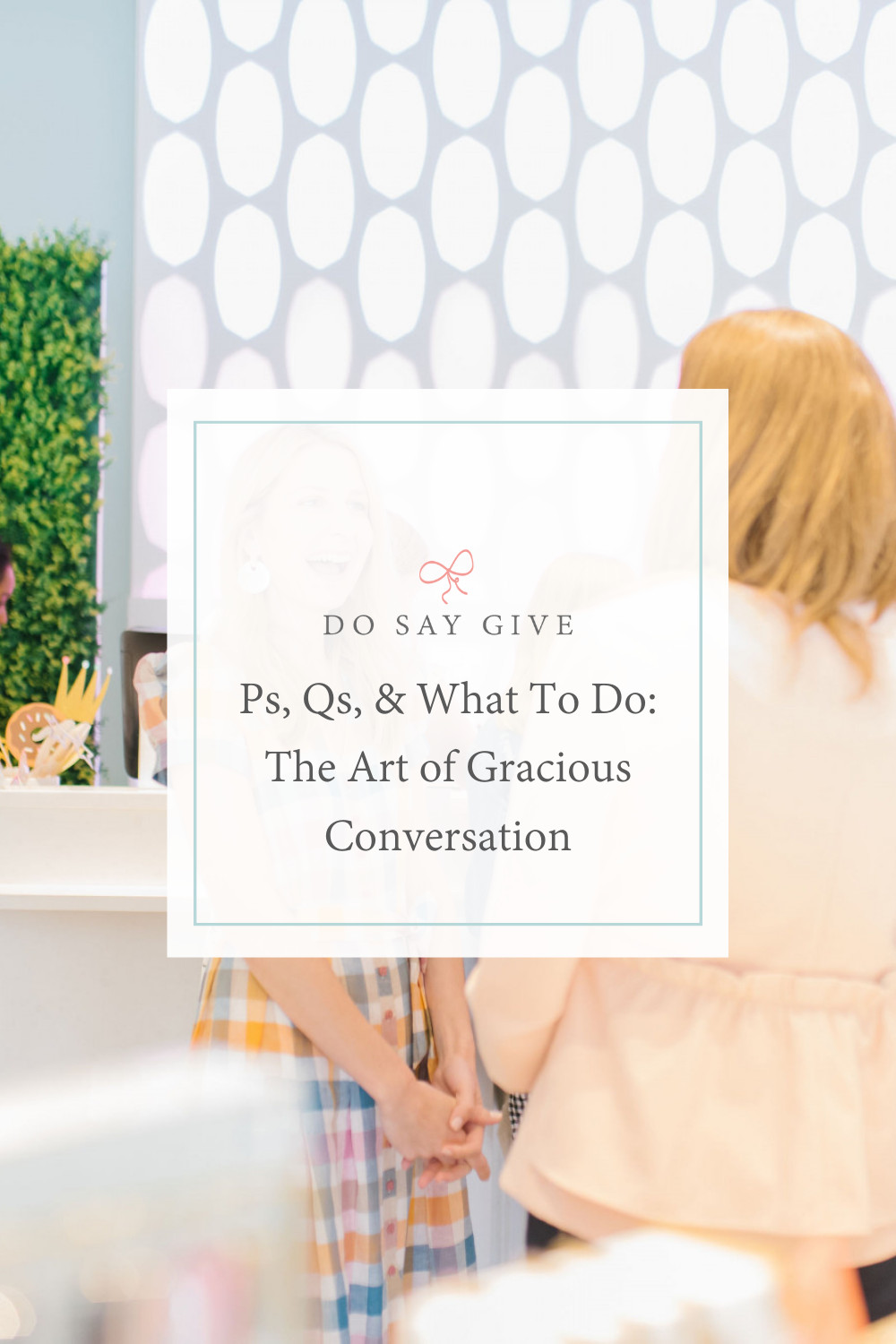A return to civility. That’s what’s been on my mind during a year that’s brought about so much tension and divisiveness within our country, our communities, and even our own families. Since kindness, inclusion, community, and — yes — manners are crucial in keeping a society both civil and thriving, I wanted to take some time to focus on the basics of polite society. As children head back to school and adults ramp up our social calendars, we think August is the perfect time to do this. So we’re excited to launch our series: Ps, Qs, and What to Do!
All month long we will be polishing up on manners basics — socially, digitally, and beyond. We need your help though in encouraging kindness, so please share our posts on your Facebook feed, stories, email your friends, and anywhere else! As we’ve been saying from the beginning, most people want to do and say the right thing but often need some guidance on specifics. So DoSayGive is happy to help!
The Dos and Don’ts of Conversation
Many of us haven’t had a typical social schedule over the last year, so there’s a good chance we’re a little out of practice when it comes to making conversation. There’s a reason “the gift of gab” and “the art of small talk” are common sayings — they really are true gifts and art forms, (not to mention stressful if you’re out of practice!). If you find yourself at an event, party, or dinner, take note of a few of these dos and don’ts to help make any conversation flow naturally.
Conversation “Do’s”
DO give your undivided attention by looking people in the eye. Act interested. Smile and nod.
DO ask engaging questions and provide pleasant subjects.
DO maintain the natural rhythm of conversation.
DO include others in conversation. (If you see someone in the peripheral, invite them into the conversation. See below for ideas.)
Conversation “Don’ts”
DON’T look at your phone or for a more interesting person to talk to.
DON’T monopolize the conversation with stories about yourself or your children.
DON’T bring up divisive subjects (e.g. politics, religion, vaccines).
DON’T be a know-it-all or humble braggart.
How to Make Introductions
How to Introduce Two People
For a smooth introduction include the following:
- How you know one another
- A connection or conversation starter
- Last names (and use titles for elders, doctors, judges, elected officials, etc.)
Example: “Jennifer, I want you to meet Carey Smith. She and I went to college together. Carey, this is Jennifer Flores, I think her children go to the same summer camp!”
How to Introduce Yourself
Give your first and last name. Make a reference point.
Hello! My name is I’m Lee Cordon. I live down the street and have been meaning to come over and introduce myself!
I’m not sure if we’ve met before. I’m Francie Smith. We recently moved here from California. \
Forgive me for not introducing myself before, I’m Anna Garcia. My daughter is loving being on the same team as your son.
What to Do When You Forget Someone’s Name
Tip #1: Introduce someone you know first!
Do you know Marjorie Smith? She is a friend of mine from college. (And hope that the other person introduces herself after that!)
Tip #2: Re-introduce yourself.
Hello! I’m Leslie Jones. We met at this conference last year.
Tip #3: Apologize and just ask!
I am so sorry, your name has slipped my memory but I know our daughters were in the same preschool class last year.
I know that I know your name, but I am having a mental block right now! Blame it on the late nights with the baby!
Tip #4: Ask them to put their email or phone number in your phone.
I keep meaning to get your phone number! Will you put it in my phone so I can text you?
Tip #5: Ask them for a business card.
Tip #6: Ask a friend.
Conversation Starter Ideas
A skilled conversationalist sometimes has to try 2-3 conversation starters to see what clicks with the other person. So don’t give up if the conversation is dragging at first! Here are some ideas to keep in your back pocket:
“How are your boys?”
“Did you go anywhere this summer?”
“Are you still with the same company?”
“Have you tried that new restaurant downtown?”
“What teacher did your daughter get?”
“Have you seen anything good on Netflix? We just finished a new series last night called…”
“Where did you find that cute necklace?”
Do you have any conversation tips to add? Please share below!
We look forward to sharing our next topic in this series next week. Be sure to subscribe to DoSayGive emails so you don’t miss it! And please share this helpful post on social media!





I have learned it only takes a moment to stop and really notice something about a person — the care they have taken with their hair for an event or a special piece of jewelry — something they put thought into and probably want noticed. I like to honor that by just paying a genuine compliment which almost always puts the other person at ease and conversation can flow naturally from there.
Dale Carnegie once noted that the people who ask thoughtful questions are the ones considered the best conversationalists so you are spot on to advise readers to come to a gathering mentally armed with a good list to things to ask others!
Yes! Thank you for this! So true and love your insight!
Great tips, Lee! I completely agree with the “reference point” or “conversation starter” tip. When I’m introducing people—which is often lately—I add in genuine praise or what I think are interesting facts. For example:
“Sarah, this is Catherine, the leader of our sales team. Catherine’s team is consistently recognized by leadership as one of the most effective teams in our company. She does a great job of implementing and scaling her teams processes.”
It takes practice and must be **genuine**, but I’ve noticed it makes my direct reports and colleagues really open up and engage.
Oh this is so wonderful. Thank you for the example!
Lee,
I have a question rather than a comment. My daughter is in first grade and has a little girl who always wants to play with her. She doesn’t want to play with her all the time and has made remarks to me that she almost feels smothered by her. Do you have any tips I can teach my daughter on how to handle this situation graciously?
Great question! I think this is an occasion to get the teacher involved (I would call her if it’s an issue) and let her know that your daughter wants to be kind and inclusive but is feeling a little smothered. I think at 6 years old it’s hard to handle these things without an adult! Hopefully the teacher can get involved and direct the other girl to additional friends.
I love the kind reminders of every day interaction and the exposure to new ideas!
Thank you
I am so glad!